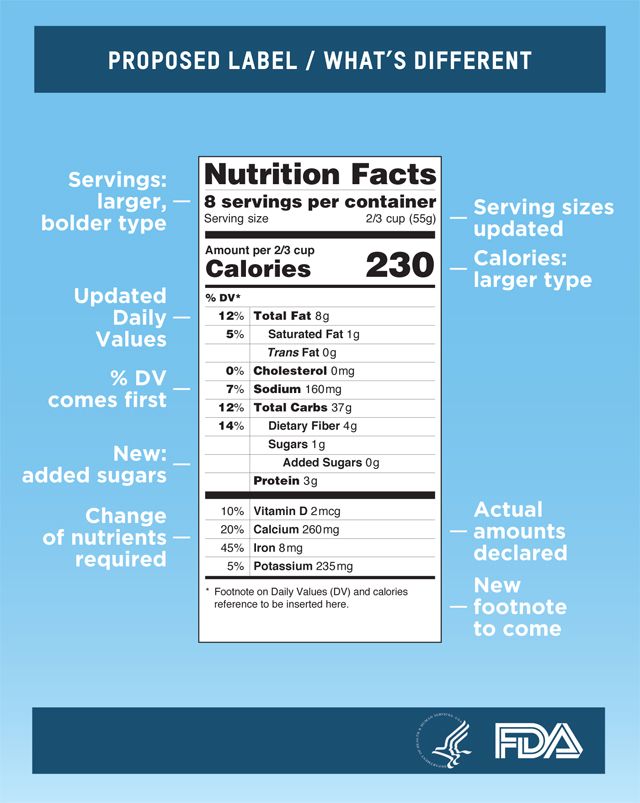NPA Petitions FDA to Stop Changes to Nutrition Facts Label, Supplement Facts Label
The NPA claims that FDA’s labeling changes would overly burden the food and supplement industries, and says that the new regulations around added sugars are duplicitous and that the agency’s new definition of dietary fiber is not backed by scientific or empirical studies.
Photo from FDA

The Natural Products Association (NPA; Washington, DC) has filed a formal petition asking FDA to shelve the agency’s proposed final rule that would enact changes to both the Nutrition Facts and Supplement Facts labels. In its petition, NPA claims that these changes overly burden the food and dietary supplement industries and run counter to the Trump administration’s goal of reducing unnecessary regulations.
The association focused heavily on two changes under the proposed final rule. The first is FDA’s proposal to list added sugars on the label. NPA says that adding an added-sugars listing is unnecessary because a listing for total sugar is already required on labels today. Given the Trump Administration’s stated goal to eradicate overly onerous regulations, NPA says it is now pushing back on what it considers “unnecessary and overly burdensome regulations” like these.
Daniel Fabricant, PhD, president and CEO, NPA, commented in a press release: “We are heartened by the Administration’s pledge to weed out bad regulations that only end up costing consumers more money, and this one is exhibit A. This rule was poorly written, rushed, unnecessary, and should be shelved immediately. Labeling is extremely important, but labeling changes posed by FDA must be material and based on scientific evidence or consumer empirical studies and not based on whim or the way the wind happens to be blowing.”
The petition notes that data from FDA’s own consumer studies do not seem to support the need to add an added-sugars listing to the nutrition label. According to the petition, “FDA relied upon consumer studies to support their reasoning for including a new declaration for added sugars” but found in these studies that consumers were largely confused about the difference between sugars and added sugars-regardless of whether added-sugar distinctions appeared on the label.
Further, NPA claims that FDA’s own eye-tracking studies do not seem to support its decision to include added sugars to the nutrition label, either. FDA’s eye-tracking study, which was conducted between January and March of 2015, analyzed the ways that consumers read various nutrition label elements. NPA says that the eye-tracking study sample size was too small and too regionally homogenous to obtain meaningful data. NPA used FDA’s raw eye-tracking data in its own independent study on the dwell time of eye fixation (how long consumers looked at individual components of the nutrition label) to determine whether there was difference in how long consumers examined carbohydrates versus added sugars. NPA found that consumers’ dwell time was lower when consumers were looking at added sugars compared to carbohydrate information, which the association said suggests that the added sugars line does not provide any added benefit.
NPA also questioned FDA’s approach to dietary fibers, stating that the agency’s decision not to include isolated or synthetic dietary fibers within its new, official fiber definition-which was promulgated as part of the proposed label changes-are not backed up by scientific or empirical studies. NPA challenged the new fiber definition in its petition, saying that it is selective and inconsistent and does not include isolated or synthetic dietary fibers such as inulin. “FDA does not treat dietary fiber consistently as it does most other nutrients,” the petition states. “FDA has chosen to define dietary fiber in accordance with a showing of its beneficial physiological effect, rather than on the basis of its chemical definition and characteristics. All other nutrients and food components are defined based upon a chemical definition or some quantitative measurement.”
Furthermore, the petition notes, “NPA does not support FDA’s current treatment of dietary fiber in the Food Labeling Final Rule, which requires industry to demonstrate at least one beneficial physiological effect in humans.”
Finally, NPA criticizes FDA’s failure to submit an economic impact analysis of the economic impact of this rule to the food and supplement industries when the final rule was announced. As NPA’s press release states, “FDA failed to submit a cost-benefit analysis to the Office of Management and Budget during promulgation of the rule, a clear violation of longstanding Executive Orders, the Regulatory Flexibility Act and the Unfunded Mandates Reform Act of 1995.”
In 2014, the FDA proposed new requirements for Nutrition Facts Labels, originally mandated in 1994 and virtually unchanged in the years since. The most notable new requirements included a new way to list serving sizes, listing of added sugars, inclusion of vitamin D and potassium content, and voluntary inclusion of vitamin A and C content. For 90 days following the proposed changes, the FDA accepted public comments, and in May 2016, the new requirements were finalized and implemented. The requirements necessarily extended beyond food products to the supplements industry, and were to be implemented by July 26, 2018; however, the FDA recently revised its compliance deadline, now July 26, 2019, giving the industry more time to complete compliance documents.
Prinova acquires Aplinova to further increase its footprint in Latin America
April 7th 2025Prinova has recently announced the acquisition of Brazilian ingredients distributor Aplinova, which is a provider of specialty ingredients for a range of market segments that include food, beverage, supplements, and personal care.










